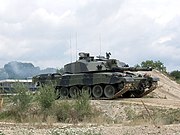Hydropneumatic suspension is a type of motor vehicle suspension system, designed by Paul Magès, invented by Citroën, and fitted to Citroën cars, as well as being used under licence by other car manufacturers. Similar systems are also widely used on modern tanks and other large military vehicles. The suspension was referred to as Suspension oléopneumatique [fr] in early literature, pointing to oil and air as its main components.
The purpose of this system is to provide a sensitive, dynamic and high-capacity suspension that offers superior ride quality on a variety of surfaces. A hydropneumatic system combines the advantages of hydraulic systems and pneumatic systems so that gas absorbs excessive force and liquid in hydraulics directly transfers force. The suspension system usually features both self-leveling and driver-variable ride height, to provide extra clearance in rough terrain.
This type of suspension for automobiles was inspired by the pneumatic suspension used for aircraft landing gear, which was also partly filled with oil for lubrication and to prevent gas leakage, as patented in 1933 by the same company. The principles illustrated by the successful use of hydropneumatic suspension are now used in a broad range of applications, such as aircraft oleo struts and gas filled automobile shock absorbers.



